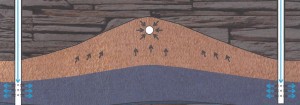DI is especially well known for its expertise and experience in improved oil recovery technology. This technology encompasses the classical IOR processes involving chemicals, CO2 flooding, thermal processes and sweep improvement. It also includes innovative applications using horizontal wells to improve waterflood performance and to enhance the performance of of gravity stabilized gas injection projects.
Use of Horizontal Wells to Improve Waterfloods
Dr. Dauben in conjunction with Grand Resources, Tulsa, Oklahoma, has been very successful in the use of horizontal wells to improve oil recovery in a mature Bartlesville sandstone located in northeast Oklahoma. SPE 99668 discusses some of the early applications. The key mechanism is the injection of water into an underlying high permeability zone using vertical wells and the drilling of horizontal wells into the upper portion of the reservoir. This in effect creates a gravity stability displacement, similar to a bottom water drive mechanism that occurs in some reservoirs. Reservoir modelling has proven to be important in the design and prediction of performance.
Horizontal injection and horizontal producing wells are useful in low permeability reservoirs where it is difficult to conduct an economically successful waterflood. Operators frequently inject above the parting pressure to obtain sufficient amounts of water injection. In so doing, however, channeling often occurs results in poor sweep efficiency and poor oil recovery. This technology is useful for shallow, tight formations and for tight, deep reservoirs where the use of horizontals is more cost-effective than vertical wells.
In another reservoir, horizontal laterals were drilled into the crest of a reservoir containing a moderately heavy oil underlain by water. Oil recovery with vertical wells had been poor due to water coning. The effect of the horizontals was to reduce the pressure gradients thereby minimizing the tendency for coning. The following figures illustrate these effects.

Gravity Assisted Gas Displacement (GAGD)
The displacement of oil by gas in a gravity stabilized environment is quite efficient. Although the displacement efficiency is high, gas injection in a flat reservoir is often inefficient due the poor mobility ratio between the oil and driving phase making for poor sweep efficiency and low oil recovery. Gas injection has proven to be quite successful in the past when injected into the crest of a steeply dipping formation or into the gas cap of an oil reservoir. In both cases, gravity forces help to spread out the displacement front and thereby minimize the tendencies for channeling due to a poor mobility ratio. Many reservoirs do have some structure but not enough to take advantage of gravity forces for gas injection. In such cases, the drilling of horizontal producing wells at the base of the formation combined with crestal gas injection can greatly improve performance.
The GAGD process is sometimes referred to as a “double displacement” process. This term refers to the ability of gas to recover additional oil even after the waterflooding or a strong water drive. This additional recovery is attributed to the greater efficiency of gas displacing oil versus water displacing oil. These effects are clearly seen in gas-oil and water-oil relative permeability relationships. The following figure illustrates this process.
Sweep Improvement
Dr. Dauben has developed considerable expertise in the diagnosis and treatment of reservoir problems caused by poor sweep efficiency. Sweep problems occur due to some combination of permeability contrasts, open fractures, permeability orientation, and an unfavorable mobility ratio. Treatments involving polymers, gels, foams,can sometimes be successful. Water-alternating-gas (WAG) is often used to control sweep in carbon dioxide floods.
DI works with several groups in the application of sweep improvement technology. These include Reservoirs Solutions Inc. for the testing of chemicals, polymer, and cross-linked polymer systems, as noted on the associations page. The major polymer supplier has been SNF Chemtall (www.snf.us). Jay Portwood of Flotek Industries has been used for the actual application of sweep improvement treatments.
Carbon Dioxide Flooding
DI has been involved in the modeling of several reservoirs that are suitable for CO2 flooding. These include a deep carbonate reservoir in Mississippi and Morrow sands in Oklahoma. CO2 flooding has proven to be quite successful in reservoirs where miscibility can be developed and where earlier waterfloods were successful. A key factor is the availability of a nearby source of CO2. CO2 is also applicable in certain reservoirs as an immiscible process. An example is the successful CO2 project in the Salt Creek Field, Wyoming. Immiscible CO2 projects are particularly successful where the crude oil is on the heavier side and can benefit by the ability of CO2 to lower oil viscosity and increase saturation by swelling of the crude oil. The following figure illustrates the CO2 flooding process.
Typical Projects
- Research and development of a horizontal well process for the improvement of waterflood recovery through sweep improvement.
- Evaluation of several reservoirs in Mississippi for the application of carbon dioxide flooding.
- Principal investigator for a Small Business Innovative Research program for evaluating mobility control agents for improved recovery from carbon dioxide flooding.
- Development of enhanced oil recovery prospects in Mexico and Venezuela.
- Assessment of the state-of-the art of steamflood technology.
- Field-wide simulation of a polymer flood in a field in India.|
- Chief Technical Advisor for a UNDP enhanced oil recovery program in India.
- Served on a National Petroleum Council team to update EOR reserves in the US.
- Buy viagra online cheap
- Renova zero for sale
- Viagra for men price
- Buy generic levitra online canada
- Buy cialis in usa online
- What do you need to buy viagra
- Can i buy renova over the counter
- Buy levitra singapore
- How do i get ventolin
- Purchase ventolin